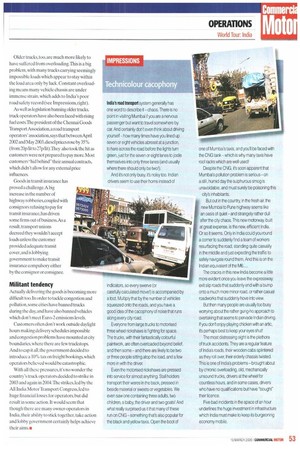India's road transport system generally has one word to describe
Page 53

If you've noticed an error in this article please click here to report it so we can fix it.
it chaos. There is no point in visiting Mumbai if you are a nervous passenger but want to travel somewhere by oar. And certainly don't even think about driving yourself how many times have you lined up seven or eight vehicles abreast at a junction, to hare across the road before the lights turn green, just for the seven or eight lanes to jostle themselves into only three lanes (and usually where there should only be two!).
And it's not only busy it's noisy too. Indian drivers seem to use their horns instead of
indicators, so every swerve (or carefully calculated move!) is accompanied by a toot. Multiply that by the number of vehicles squeezed onto the roads, and you have a good idea of the cacophony of noise that runs aiong every city road.
Everyone from large trucks to motorised three wheel rickshaws is fighting for space. The tucks, with their fantastically colourful paintwork, are often overloaded beyond belief, and then some and there are likely to be two or three people sitting atop the load, and a few more in with the driver.
Even the motorised rickshaws are pressed into service for almost anything. Stall holders transport their wares in the back, pressed in beside material or sweets or vegetables. We even saw one containing three adults, two children, a baby, the driver and two goats! And what really surprised us it that many of these run on CNG something that's also popular for the black and yellow taxis. Open the boot of one of Murrlaa's taxis, and you'll be faced with the CNG tank which is why many taxis have roof racks which are well used!
Despite the CNG, it's soon apparent that Mumbai's pollution problem is serious on a still, humid day the sulphurous smog is unavoidable, and must surely be poisoning this city's inhabitants.
But out in the country, in the fresh air, the new Mumbai to Pune highway seems like an oasis of quiet and strangely rather dull after the city chaos. This new motorway built at great expense, is the new, efficient India. Or so it seems. Only in India could you round a corner to suddenly find a team of workers resurfacing the road, standing quite casually in the middle and just expecting the traffic to safely navigate round them. And this is on the Indian equivalent of the M6„.„ The cracks in this new India become a little more evident once you leave the expressway; exit slip roads that suddenly end with a bump onto a much more minor road, or rather casual roadworks that suddenly hove into view.
But then many people are usually too busy worrying about the rather gung-ho approach to overtaking that seems to pervade Indian (InvIng. If you don't enjoy playing chicken with an attic, it's perhaps best to keep your eyes shut!
The most distressing sight is the plethora of tuck accidents. They area regular feature of India's roads, their wooden cabs splintered as they rollover, their elderly chassis twisted. This is one of India's problems brought about by chronic overloading, old, mechanically unsound trucks, drivers at the wheel for countless hours, and in some cases, drivers who have no qualifications but have 'bought" their licence.
Five bad incidents in the space of an hour underlines the huge investment in infrastructure which India must make to keep its burgeoning economy mobile.










































































































































































































